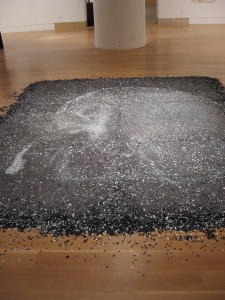Maybe because Murray’s mother died a month ago (see his Op Ed in today’s Inquirer), two works in the big Philagrafika 2010 exhibit have been gnawing about me.
Pepon Osorio at Pennsylvania Academy of the Fine Arts has printed a blow-up of an X-ray image of his mother’s skull atop a thick, black bed of confetti, laid on the floor like a fresh grave. The installation is to honor the memory of his mother, who died recently. And the memorial suggests all the medical interventions that fail and the way an individual, irreplaceable and unique and loved, is quantified in an X-ray (which of course is a form of print). The juxtaposition of confetti and death and dying stopped me in my tracks.

I had thought prior to seeing this that if I never saw another skull in an art work, that would be all right with me. Of course that was based on all the cliche skulls that abound in contemporary kitsch, plus a dose of too many Day of the Dead and Halloween illustrations.
Osorio, an internationally renowned artist who lives and works in Philadelphia, was born in Puerto Rico, and Latin ideas about death and mourning come through in this work, along with his personal pain.
Another Latino, Colombian artist Oscar Munoz, at the Philadelphia Museum of Art. has created prints, some of them self-portraits, others portraits of others, printed on water.
The self-portraits, Narciso en proceso (Narcissi in process), are charcoal (ash) images that gets fuzzy and sometimes disintegrate altogether as the evaporating water deposits the charcoal onto paper. Munoz has been making these self-portraits, since 1994, and the implication is he himself, as he ages, is dying, vulnerable and ephemeral. The materials–paper, water and charcoal image–are boxed in plexiglas so we can watch the disintegration, each box a little coffin.
His other series, Biografias (Biographies), are portraits of people who have died or disappeared. The portraits are videos projected onto the floor. Each ink portrait is deposited on water in a rectangular basin with a center drain. The portraits morph and dissolve as they go down the drain. And the only print that remains is the video of the process.
The videos are cool and horrifying–the implication of descent down the drain or into the ground is rough. There’s an implication here that society is the machine that created these losses. But it’s the gentler process of the ashy charcoal deposited on paper, that packs the bigger wallop. The material itself implies death and cremation, and the slowness of the process, with its successes and glitches, offer more of a sense of the vulnerability of the artist, as well as a sense of the vulnerability of the printed image. The ills and inequities of society seem like something fixable compared to the human condition, for which there is no cure.
I hardly know how to cover the mass of marvelous stuff that is out there in Philagrafika-related shows. So I’m saying what I have to say piecemeal, and am leaving the big picture to everyone else.









